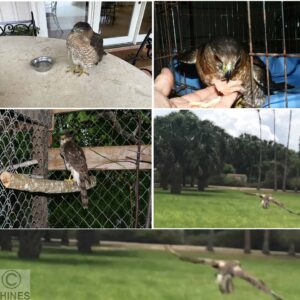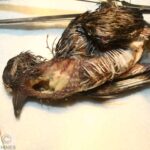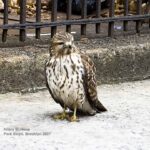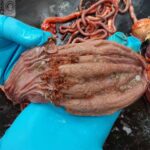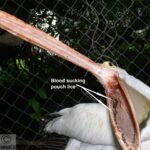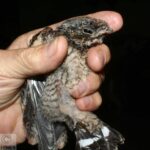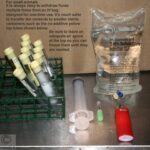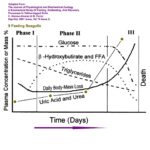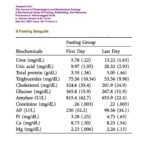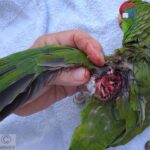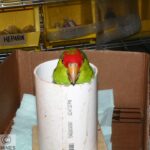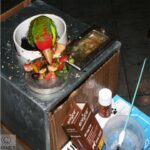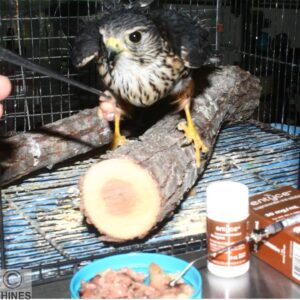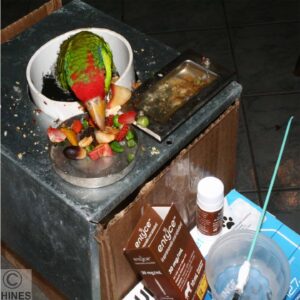What To Do For Birds That Can’t Or Won’t Eat
Ron Hines DVM PhD
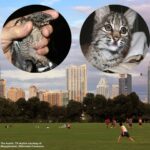 All Of Dr. Hines’ Other Wildlife Rehab Articles
All Of Dr. Hines’ Other Wildlife Rehab Articles
There will be times when people bring a wildlife rehabilitator like you, or an avian veterinarian, a bird that is reluctant to eat. Its underlying health issue(s) might be apparent or they might not. But after examining the bird and finding that it has practically no remaining breast muscles and is severely underweight you know that starvation is now its number one life-threatening concern.
Domestic and wild mammals carry fat reserves that get them through periods of fasting. But wild birds had to sacrificed that ability as a trade-off for the ability to fly. The penguin is the only bird I know of that accumulates fat to get it through its egg-incubation fast.
The smaller the bird species is, the less time it can survive without eating. Small songbirds can only survive for a day or two without eating because their metabolic rate (need for calories) is so great. Owls can manage for 8-10 days; vultures for about 13 days. During those periods they often loose almost a third of their normal weight. Because most of that is muscle mass, they soon lose their ability to fly. Along with that, their metabolic rate and body temperature drops.
Vision Problems
The first thing I check is the bird’s vision. Some of those birds have traumatic cataracts – the result of their lenses rupturing from their attachments due to a head collision. I see it most frequently in owls Blind wild birds tend to be abnormally docile. Although they cannot eat on their own they usually will accept food when it brushes against their beak. Using an ophthalmoscope, the pecten can often be seen to be displaced in their eye.In others, the clear corneas of their eye are milky and inflamed. In my area it is common for those birds to have been sprayed by crop dusters applying pre-harvest cotton defoliants. Some of those birds regain their vision with time when their eyes are flushed with saline and a bland, protective ointment is applied. Some never do.
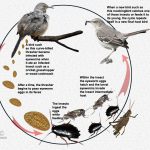 On rare occasion, eyeworms can be the source of vision problems that prevent successful feeding. You can read more about those parasites here. Similar to other problems that concern only the bird’s eyes, these birds will readily eat when given assistance.
On rare occasion, eyeworms can be the source of vision problems that prevent successful feeding. You can read more about those parasites here. Similar to other problems that concern only the bird’s eyes, these birds will readily eat when given assistance.
Raptors Unsuccessful At Hunting – Starvation
I commonly see starvation problems in raptors when they can no longer hunt successfully. Many of these are young-of-the-year birds that have left their parent’s nest but were unsuccessful in hunting on their own for a variety of reasons. It is rare for all hatchings to go on to reach breeding age. Some are naturally better hunters than others. But normal year-to-year climatic changes that make rodents and other of their prey animals less plentiful are probably the main underlying factor. At some point these underfed birds no longer have the strength to fly. When they are brought to me and are still alert, they have all recovered when food was provided. When they reach their normal weight, I release them. How they fair in the wild after that I do not know.
Coordination Problems In Raptors
Every year a number of mature raptors, screech and barn owls arrive showing coordination problems that make it impossible to successfully hunt. For unknown reasons, Cooper’s hawks top the list – both here in Texas and at another rehab center sought of Tampa that I am associated with. Neither Texas Parks & Wildlife nor Florida Fish & Wildlife Commission provide wildlife rehabilitators diagnostic support as to the causes of wildlife mortality in their States. But my suspicions fall on three possible causes. The first is the increased use of bromethalin-containing rat and mouse poisons. There is no known antidote. Bromethalin has now become so dispersed in the environment that levels of the compound are common in non-raptor birds as well.
West Nile Virus
Another known cause of incoordination and starvation in birds is exposure to the west nile virus carried by mosquitoes. Although any bird is susceptible to WNV infection, ravens, crows, blue jays and raptors seem to be the most susceptible to incoordination problems and death when exposed to this virus. Again, there is no specific treatment and I know of no cases where birds that are already showing symptoms have recovered.
Algae Exposure
Animals that dwell near water impoundments and slow-flowing waterways containing hydrilla face another cause of incoordination and starvation. It is due to exposure to a non-native “sea weed” plant first imported in the 1950s from Asia to embellish fish aquariums. When dumped into the freshwater canals of Florida, this plant soon became established in the entire Southern United States. Hydrilla is not in itself poisonous. But a form of algae (Aetokthonos hydrillicola) that enjoys growing on hydrilla can be toxic to wildlife that prey on animals like nutria that are exposed to it. Raptors like eagles are high on that list. The algae only become toxic when there is sufficient bromine in the water. (read here) High water bromine levels are associated with water polluted with pesticides, dyes, gasoline and various plastics production. Similar incoordination problems occur in sea birds and sea mammals exposed to fish prey that have ingested domoic acid -containing algae. Either problem eventually leads to starvation and death.
Trichomoniasis
Unlike the trichomonas of humans, the trichomonas that infects birds is a digestive tract parasite. For unknown reasons, doves and pigeons in particular often carry these parasites in low numbers in their esophagus and crop. Perhaps that is due to the fact that all columbine birds produce crop milk that is rich in nutrients for these parasites to feed on. Perhap because they all regurgitate that crop milk into their offspring. In doves and pigeons, it only causes a problem in stressed individuals. Most lead normal lives. Perhaps due to the esophagus and crop feeding of hatchlings in wildlife rehabilitation settings, the parasite can produce a gullet inflammation that prevents food from reaching the stomach. The juvenile mourning dove in the photo above is one of those casualties. When caught early, these birds often improve when given oral metronidazole (Flagyl®). You can read more about that medication and others similar to it here.
Trichomonas infections are considerably more common in the raptors maintained by falconers than in raptors in the wild. In that cruel sport, raptors are perpetually maintained in a semi-starved condition as an inducement to return to their captors for food. Their body weight is strictly regulated to be sure that they are always hungry. Over the centuries that falconry has been practiced, some falconers pull the heads off of captured doves and other birds before allowing their raptors to eat them believing that the majority of the trichomonas parasites were eliminated in that way. Metronidazole is available on most falconry websites. When you encounter a wild raptor weakened by trichomonas, it is usually one living in an urban setting that is feeding primarily on street pigeons. Some people refer to the mouth lesions found in these birds as canker. But canker is better used to describe an oral fungal infection with candida. Candida does not respond to metronidazole. It often responds to nystatin. An oral skin scraping will tell the two apart.
Other Parasites
The brown and white pelicans and cormorants that come to me all have few contracaecum parasite. But heavy infections with contracaecum , as shown in the first photo are common as well. These nematode parasites are found in the bird’s stomach. But in heavy infections they are known to burrow through the stomach lining and reside in the surrounding tissue causing inflammation. These parasites can probably infect any fish-eating bird. But they seem most common in those that feed heavily on mullet – their intermediate host (previously frozen mullet are safe). I can not tell you how these parasites affect the bird’s appetite. All that have arrived have had other parasites such as the blood sucking pouch lice (Piagetiella peralis) shown in the second white pelican photo, leg or wing issues that might also account for their reluctance to eat. But ivermectin – fed within a fish at the proper dose – cleanses these bird of all these larger parasites. You can read more about ivermectin use here.
Species Feeding Strategies And Preferences
Getting swallows to eat on their own is always a challenge. These birds are hardwired to only eat while flying. There are no easy solutions. Perhaps Entyce® that I discuss further down this page might help. Read about the challenges of successfully raising swallows here.
Because I am located near the coast, ospreys occasionally come in emaciated after having being trapped in open-topped beachfront lanais (screen porches). I use fish traps and cast nets to obtain fish for them. Some ospreys that come in aren’t even interested in eating fish that are still flopping in the bucket. Here again Entyce® might be helpful. My best success is housing new arrivals close to other ospreys that are already eating.
What Should I Do?
The majority of reluctant eaters come to me in a dehydrated condition. By the time an adult wild bird stops resisting capture it is in the later stages of starvation, its body temperature is often subnormal and it has not drank or consumed water-containing prey for some time. Dehydration kill faster than starvation. It needs to be addressed first. If the bird will drink water offered to it, fine. Pedialyte™ is fine too if they will accept it. If not, my choice is sterile 0.45% saline with 5% dextrose solution that I administer to the bird subcutaneously. Birds that are not dehydrated due to diarrhea or vomiting do not require Ringer’s solution. None of the electrolytes found in Ringers are lacking in those birds. When diarrhea, vomison or blood loss is the issue, Ringer’s solution with 5% dextrose is what I give by injection. Either needs to be given in frequent, small, slowly administered amounts. I never repeat an injection until the previous fluid “bleb” has dissipated. Giving fluids intraosseously (in a distal wing bone) or intravenously is tricky business. It is so easy to overload a small bird’s circulatory system with “mainline” intravenous or intraosseous injections. The end result can be pulmonary edema. I only used those two techniques when birds arrive near death and I know that time has about to run out for them. Since intravenous or intraosseous fluid administration in crisis situations is so rarely successful, I am much more likely to place them in a high-oxygen environment (portable oxygen generator) ![]() , give them supplemental heat when required and pray.
, give them supplemental heat when required and pray.
You must also be cautious when adding heat sources to chilled birds since they are unlikely to move closer or farther from a heat source to find their optimum temperature.
Subsequent to those treatments, fortunate birds perk up – generally within 4-10 hours. That is the time I begin to offer various foods – dipped in water to see which might interest it most. All birds in that situation need as much balanced protein as they are capable of consuming. Injections of B-complex vitamins (eg Liver-7™) might be helpful in stimulating a reluctant bird’s appetite. For raptors, my first choice is always diced raw chicken liver offered with long forceps. Wild birds do not like people peering down at them. Keep their cages at your eye level.
If the bird still will not eat, your only recourse is tube feeding. Various “emergency formulas” are commercially available. But I have never found them to be any more beneficial than a bird’s normal diet liquefied in a blender and given in very small warmed amounts throughout the day. Aim for a volume in milliliters of ~3 % of the bird’s body weight of blender-diluted food per feeding on the first day and gradually work up from that. When water no longer needs to be added and the bird is eating on its own, birds of 100 grams normally consume about 25% of their body weight per day and 700 gram birds about 15%. Cut back on the amount of food fed per feeding if vomiting occurs or the crop does not empty. Remove feathers, fur and bone from prey animals until the bird is alert and active. A steady weight gain in emaciated birds is the best indication of success.
What Have Researchers Learned About Avian Starvation Over The Years?
A few bird species have adapted to survive fasting better than others. These are mostly open sea seabirds that feed on sea life which is only plentiful seasonally or in spurts. Those birds have a much greater ability to store energy in their bodies as fat than land-dwelling birds do. But in all birds, when fat stores run out, the bird must rely on the proteins that comprise the muscles of its body to continue to survive. When that occurs, the uric acid level in their blood increase dramatically. Uric acid is a waste product generated in birds and reptiles when protein is disassembled to provide glucose for energy. It is that tough chalky white material on your cage bottoms that is so hard to wash off because it is practically insoluble in water. You and I and all mammals eliminate the waste nitrogen of our protein breakdown in the form of less toxic urea . Urea easily dissolves in water. Birds also excrete some urea. But not in the large amounts present in mammalian urine. When non-fasting birds and reptiles blood uric acid levels increase, the cause is kidney failure that has resulted in gout. Read about gout in birds here.
What Is Occurring In Fasting Birds At A Cellular Level?
The result of a bird using up its structural body proteins for energy is a sharp drop in body weight. Looking at the constituents of its blood, the triglyceride level steadily drops as fasting time increases. Those triglycerides, a quick source of energy, come directly from the food a bird eats, as well as through internal synthesis from carbohydrates and proteins found in the food. The more a bird’s body relies on its liver to synthesize life-sustaining glucose, the more ketone bodies are produced. Ketone bodies at high levels are toxic. Read about that here. Free Fatty acids (FFAs) are also a component of body triglycerides and prey. FFAs serve as an alternate source of caloric energy that birds can readily utilize. But as you can see from the two graphs above FFAs and their derivative, hydroxybutyric acid are quickly used up when birds do not or cannot eat.
How Long Can A Bird Go Without Eating?
In the study of nine non-fed seagulls from which the graph and blood values in the photos above are derived, eight died on the eighth day. By that time they had lost 15% of their body weight. The remaining one recovered when given oral glucose, vitamins and food. ( ask me for Alonso-Alvarez2001 ) In another study, seven European buzzards – a species known to survive periods of food unavailability – were denied food for 13 days. They lost 26% of their body weight. By that time, their blood glucose (sugar) level had dropped by about a third, their blood uric acid and urea levels had more than doubled and their blood protein (albumin) level had dropped by more than half. (ask me for Garcia-Rodregues1987)
The time of year that a fast begins is also important. In American juncos and white-crowned sparrows, fat begins to accumulate just before their fall and spring migrations. That allows them to meet the challenge of finding scarce food during their journeys. (ask me for Goodridge1984) I live in the tropics. But the risk of starvation in mature birds in more northern regions is higher in the winter when daylight hours for feeding are reduced, temperatures are low requiring birds to use more calories to maintain their body temperature, and snow cover sometimes makes food less inaccessible.
Barn owls also find obtain sufficient rodents during the winter a challenge. After about 8 days without food, in the eight birds studied, blood uric acid and urea levels began to rise as their bodies shifted to converting their muscle mass into necessary energy (glucose calories). Their body weight by then had dropped by about 28%. At the same time the level of fatty acids in their blood decreased – a sign that their fat reserves had run out. They estimated that the owls might have survived an additional 2.5 days before they died of starvation. (ask me for Handrich1993)
Bigger species of birds tend to tolerate a lack of food longer than smaller birds do. In a study of one of the smallest American raptor, the kestrel (sparrow hawks), the body temperatures of intentionally-fasted birds declined continuously over a 3.3-day period (from 39.3 C to 38.3 C). By the third night of fasting, their metabolic rate had declined 23.4% and their average weight had decreased by 18.25%. Prior studies at that facility indicated that kestrels began dying of starvation when their body weight had dropped to 70% of their normal weight. To prevent that from occurring, this particular study was halted at 3.3 days. At that time each bird was given 2 ml of Gatorade by mouth every half hour for two hours and as much chicken meat as it would eat. All birds returned to normal body temperature and metabolic rate within 24 hours. None died. (ask me for Shapiro1981)
How Much And How Often Should I Offer Food To Starving Birds?
I offer small amounts of food to starving birds (birds that have “gone light”) every 30 minutes or so. I hesitate to tube them because the stress that tubing causes can be fatal. I am more likely to give them subcutaneous injections of 5% dextrose – either in 0.45% saline or in Ringer’s solution depending on how dehydrated they appear to be. Five percent dextrose does not provide enough calories to sustain life. But these birds are generally dehydrated as well and the fluid can be quite helpful in perking them up. Successful rehydration is generally quickly followed by a “splatty” (very liquid) bowl/urine movement. We know from studies in humans that long periods of not eating cause many life-threatening changes in the mineral and hormonal constituents of the blood and cells of the body. However practically nothing is known about how starvation affects those body constituents in birds. So there is no agreement among wildlife rehabilitators or veterinarians as to the best ways to transition starving birds back to normal eating. Perhaps, as in humans, a thiamine injection would be helpful in the treatment of starvation. No one really knows. Commercially available products marketed for avian emergencies are all guesswork, conjecture and hype.
Appetite Stimulants For Wildlife Of All Kinds
Birds and other wildlife brought to you in a state of advanced starvation often have no interest in eating due to depression. I do not know how much of that depression is physical and how much of it is mental. The wild parrots with the fractured wing in the second photo was one of them. After I placed a stainless steel pin in its broken wing, it refused to eat. It also started pulling out its sutures and chewing at its wounds – hence the pvc tube. Despite our good intentions, mature wild creatures, forced to depend on you or on me are in a completely unnatural and highly stressful environment they were not designed to navigate. Even if you succeed in forcing food into them, their ability to digest and benefit from the food’s nutrients is probably considerably lower than in the wild.
Wildlife rehabilitators all face times when an animal we care for won’t eat. For me, it’s usually a bird – perhaps a swallow, a martin or a nighthawk – species that only eat on the wing. Perhaps it’s that reluctant osprey or eagle. But mammals with internal injuries, serious internal disease can be just as big a challenge. In those cases appetite stimulants administered orally with a ball-tip hypodermic needle might be an option. Or perhaps an injectable steroid medication such as dexamethasone might help – a “kick start” to independent eating. Dexamethasone also appears to be helpful in managing shock. The tray above shows some of the known veterinary appetite stimulants known to be effective in dogs and/or cats. But not all appetite stimulants that help in dogs and cats are work in every species. I often rely on the advice of professor Christoph Mans, the wildlife and special species specialist at the Veterinary College, University of Wisconsin, Madison. He is the only person I know of who has studied appetite stimulation in wildlife in a thoughtful scientific way. If you have a question regarding appetite stimulation in your rehab wildlife, anesthesia techniques, pain control or wildlife medications and diagnostic techniques in general it would be wise for you to contact his group directly.
Professor Mans informed me that in birds, diazepam (Valium®) ,given intramuscularly by injection, was a powerful appetite stimulant in bald eagles and the parakeets he studied. They found that midazolam (Versed®) a tranquilizer drug similar to diazepam, was also an effective appetite stimulant in birds. Cyproheptadine (Periactin®) that some veterinarians dispense to dogs and cats that are hesitant to eat did not have a significant appetite-stimulating effect in the birds they administered it to. Nor did mirtazapine at the doses administered. Mirtazapine (Remeron®) an appetite stimulant that is often effective in cats (and available as a feline transdermal cream, Mirtaz® . The Wisconsin group found that is was ineffective orally as an appetite stimulant for budgies when given at 1 or 5 mg/kg. It use was also was associated with regurgitation (vomiting) when the higher dose was given.
Capromorelin / Entyce
In 2001, scientists at Pfizer, began looking for drugs that might be useful in retarding the human frailties of old age. One of the compounds they examined was capromorelin, a drug that mimics some of the effects of growth hormone (GH) produced by the pituitary gland. Capromorelin passed its early clinical trials in elderly humans. They gained weight. But it was eventually abandoned because of a number of side effects associated with its long-term use. The early safety studies were done in beagles. The Pfizer scientists noticed that after receiving capromorelin, the dog’s appetites were greatly increased. The patent for capromorelin was eventually purchased by Eli Lilly, which sells to veterinarians as Elanco™. Aratana, an earlier developer now part of Elanco, named capromelin for dogs Entyce®. A newer addition is Elura®, a lower strength capromorelin product marketed as an appetite stimulant for cats. You can read about those products here and here. I have used Entyce® in parrots and falcons. I am happy with the results. Next summer I will see if it helps encourage swallows to eat on their own.
Cannabis Oils?
The ingredient in marijuana/hemp/cannabis that stimulate appetite THC/cannabidiol (tetrahydrocannabinol) is thought to do so in mice by increasing food odor intensity. Although the same effect often occurs in humans, long term THC inhalation or ingestion actually results in weight loss. The other active ingredient in cannabis is THCV (tetrahydrocannabivarin) Despite a lack of scientific evidence, veterinarians see financial opportunities in marketing cannabis oils to the owners of dogs and cats with various health issues – or no health issues. They are currently harmless because they contain only infintesimal amounts of THC or THCV. They are basically homeopathic in nature. What, effects, if any, THC/THCV products might produce in wildlife that are hesitant to eat is unknown. In experimental dogs the drugs were associated with something similar to serotonin syndrome. Read about that here.

